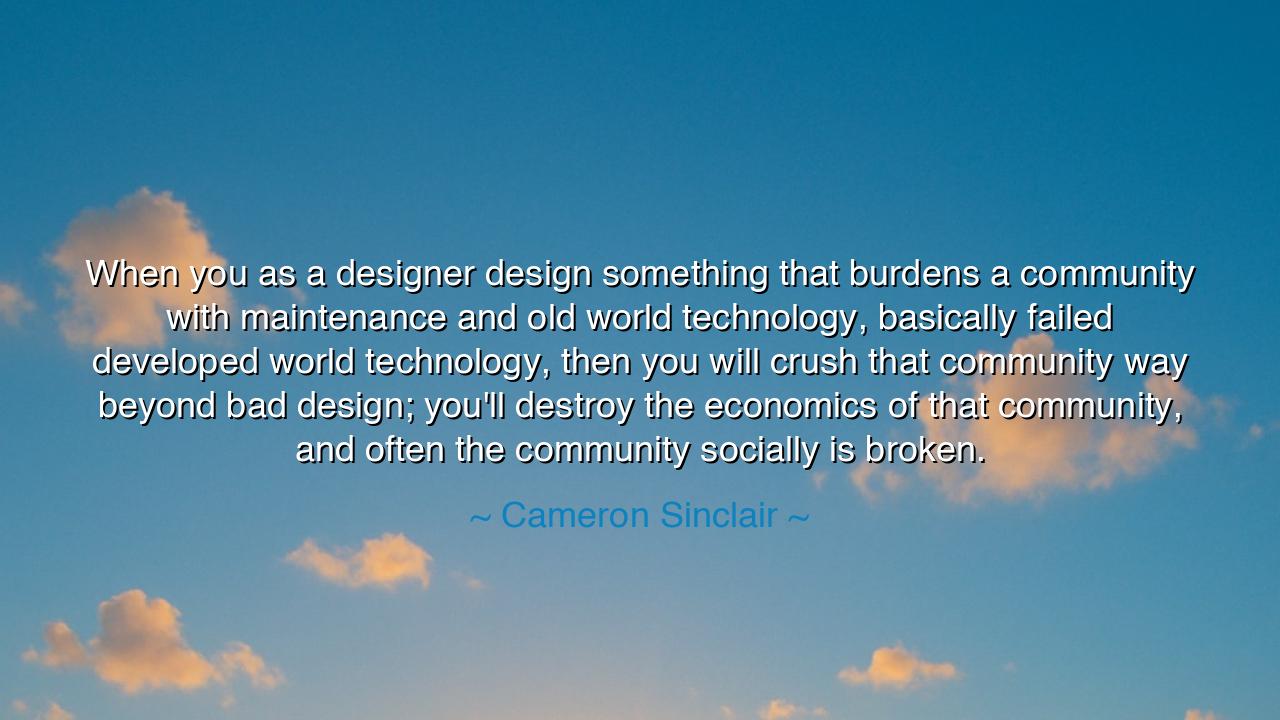
When you as a designer design something that burdens a community
When you as a designer design something that burdens a community with maintenance and old world technology, basically failed developed world technology, then you will crush that community way beyond bad design; you'll destroy the economics of that community, and often the community socially is broken.






“When you as a designer design something that burdens a community with maintenance and old world technology, basically failed developed world technology, then you will crush that community way beyond bad design; you'll destroy the economics of that community, and often the community socially is broken.” Thus spoke Cameron Sinclair, the architect of compassion, the builder who saw beyond blueprints to the beating hearts that dwell within walls. His words strike like the hammer of truth upon the anvil of conscience. They remind us that design is not merely the shaping of form, but the shaping of destiny. To build without wisdom, to impose technology without understanding, is not creation — it is destruction masked as progress.
Sinclair’s wisdom was not born in ivory towers but in the dust of the world’s forgotten places. He is the founder of Architecture for Humanity, a movement born from crisis — from the ruins of war and the aftermath of disaster. He witnessed with his own eyes how noble intentions, poorly executed, could harm the very people they sought to help. Western architects would arrive in devastated lands bearing gleaming technologies, complex systems, and costly materials that the locals could neither maintain nor afford. What began as a gesture of generosity became a burden, a structure destined to decay. In such moments, Sinclair saw that bad design was not simply aesthetic failure — it was moral failure.
The ancients understood this lesson well. The builders of old — from the stonemasons of Egypt to the carpenters of Japan — designed not for themselves, but for the people and the land. They built with materials that grew beneath their feet and tools that their hands could repair. Their temples, bridges, and homes endured for centuries because they were born from understanding, not arrogance. The wise designer knows that the greatest art lies in harmony — harmony between invention and environment, between human need and human capacity. When this balance is broken, what is built becomes not shelter, but a weight upon the spirit of those it was meant to serve.
Consider the tragedy of certain postcolonial projects in Africa and Asia, when foreign engineers brought grand water systems, electrical grids, and concrete cities modeled after Western ideals. At first, they shone like modern marvels. But as the years passed, pumps rusted, wires snapped, and maintenance required imported parts and expertise that the locals could not sustain. These technologies became monuments to failure, symbols of dependence instead of empowerment. What could have been an act of creation instead became an act of quiet devastation — not only economically, but socially, for a community that cannot sustain its own infrastructure begins to lose faith in itself.
In contrast, the true designer — the one who listens — brings solutions that belong. Sinclair once told the story of a rural village where he helped rebuild after an earthquake. Instead of concrete towers, his team worked with local artisans to revive traditional bamboo techniques, strengthened with modest innovations suited to the climate and the people’s skills. The result was not a foreign structure imposed upon the landscape, but a home born of both old and new — sustainable, beautiful, and deeply human. Through such acts, design becomes dignity, and innovation becomes harmony.
From this truth arises a deeper lesson: that progress divorced from empathy is regression. The designer, the engineer, the creator must never forget that their work touches lives, shapes economies, and weaves or unravels the social fabric. Every act of design carries moral weight. To burden a community with systems it cannot sustain is to rob it of self-reliance; to empower a community with tools it can own and understand is to give it the gift of freedom. Thus, the wise creator must not ask, “What can I build here?” but “What can they build with me?” The greatest design is not what dazzles, but what endures.
So, my child, let this be your teaching: do not build to impress, build to uplift. Seek not the glory of innovation, but the humility of understanding. When you design — be it a structure, a system, or even a way of life — let it grow from the roots of the people it will serve. Study their hands, their soil, their traditions; learn the rhythm of their needs and dreams. Then, and only then, will your creation breathe life rather than consume it.
For as Cameron Sinclair reminds us, the designer wields a power greater than art — the power to heal or to harm entire communities. Use that power wisely. Let your works be as the wise builders of old — shaped by compassion, sustained by simplicity, and rooted in respect. For when design honors both humanity and place, it ceases to be mere architecture — it becomes justice made visible, and in that justice, the world itself is renewed.






AAdministratorAdministrator
Welcome, honored guests. Please leave a comment, we will respond soon